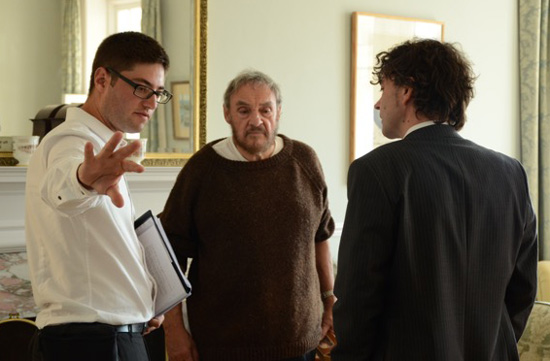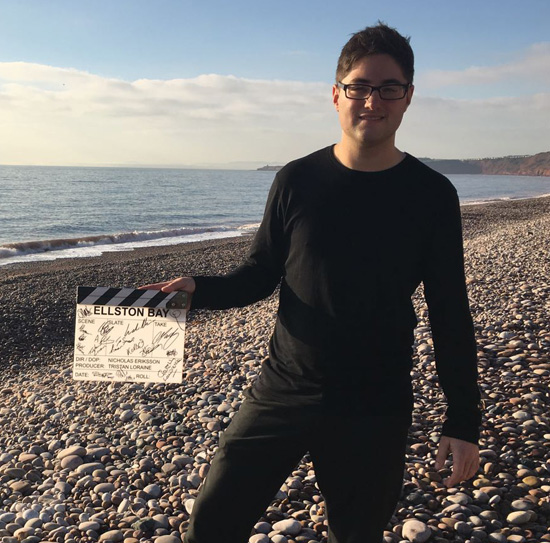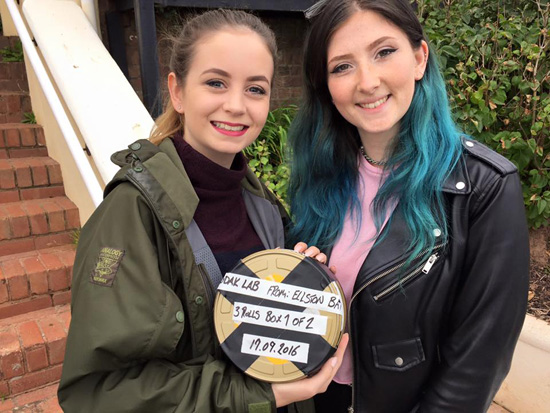The Making of ‘Ellston Bay’ |
Read more at in70mm.com The 70mm Newsletter |
| Written and photographed by: Nicholas Eriksson | Date: 13.02.2017 |
 Director
Nicholas Eriksson alongside John Rhys-Davies and Richard Kovacs Director
Nicholas Eriksson alongside John Rhys-Davies and Richard KovacsPrincipal photography on the ambitious large-format short film ‘Ellston Bay’ concluded recently, marking the first time in a very long period that the 35mm VistaVision format has been utilised exclusively for a dramatic production. Below, Director and Cinematographer of the project Nicholas Eriksson talks further about the challenges of originating on VistaVision, and the benefits of using such a large negative area. Nicholas Eriksson on ‘Ellston Bay’... It is a great relief to be writing this after an extended period of testing and planning to ensure that working with VistaVision would be a smooth experience. It is a little surreal to discuss working with one of the greatest motion picture formats ever devised, especially after such a long campaign to get the project off the ground. Working with VistaVision was a relatively painless experience, but I did need to adapt my usual shooting approach to accommodate some of the eccentricities of the format. I always felt that Ellston Bay needed to have a great sense of grandness to the imagery, and not on a panoramic scale as is common to films shot in the 2:35:1 aspect ratio. I have always found the native IMAX origination and projection aspect ratio of 1:43:1 to be the most visceral and cinematically immersive way to experience a film. |
More in 70mm reading: in70mm.com's page about VistaVision Gallery: Photography at the Pinewood Studios' Underwater Stage "Ellston Bay" - in VistaVision Gallery: "Ellston Bay" - in VistaVision Horizontal VistaVision Projector Nicholas Eriksson Director of Photography +44 (0)7858 568 945 Ellston Bay Office 2, The Courtyard 30 Worthing Road Horsham, West Sussex RH12 1SL United Kingdom |
 The
cast and crew of 'Ellston Bay' on location in Budleigh Salterton, Devon The
cast and crew of 'Ellston Bay' on location in Budleigh Salterton, DevonWhen I realised that VistaVision was a good fit for the taller IMAX aspect ratio of 1:43:1, I decided to pursue originating ‘Ellston Bay’ in the format. VistaVision is natively somewhere around 1:5:1, though is frequently cropped to either 1:66:1 or 1:85:1 for theatrical release – (most VistaVision films tend to be 1:85:1). Ian Speed at Camera Revolution did a great job in helping us prepare for the project. Ian was worried that we may have an issue with the shutter mistiming in the event of a jam, and so decided to only supply us with 400ft magazines, as this lowers the chances of a jam considerably. Whilst working with 400ft magazines is preferable in terms of weight and agility (especially with regards to handheld and Steadicam operation) it did give us limited running times to work with. A 400ft roll gives about two minutes of footage, whereas the 200ft shortend loads frequently gave us less than a minute. This never became a problem however, especially as time was always against us, and I knew that a couple of takes was all I needed. If we had to reload then we would just bite the bullet and go ahead, but rarely did I feel that I was compromising when working with shorter loads. I decided early in pre-production that I wanted the images to have a naturalistic quality, and to be free of heavily stylised visual elements. I also wished for the audience to be able to survey the scene as our protagonist is free to do. In terms of framing and composition, this meant regularly sticking to wider focal lengths, and avoiding unnecessary close-ups where possible. In order to fully realise the potential of the VistaVision negative, I began researching the possibility of utilising Hasselblad V Series stills lenses on the camera. Hasselblad lenses are frequently utilised on IMAX and 65mm productions. The lenses exhibit excellent sharpness characteristics, and were built for medium-format usage in stills photography, so the back element can easily cover the requirements of large-format cinematography. |
|
 2nd
AC Julian Sharma lines up the VistaVision frame during testing at Arri
Rental, London¨ 2nd
AC Julian Sharma lines up the VistaVision frame during testing at Arri
Rental, London¨I set about importing a Hasselblad V Series > Leica R-mount adaptor from Chicago, USA, as I knew this was our only affordable chance to mount alternative glass to the camera. With the kind assistance of the entire team at Camera Revolution, and Bob Campbell at Arri Rental, we managed to remove a lot of the excess metal that made mounting the adaptor difficult. Following extensive lens tests with Camera Assistants Andrew Bradley, Karl Hui and Julian Sharma, I was relieved to discover that the lenses performed very well, and gave us the crisp, sharp imagery I had been looking for. Whilst re-housing the lenses was completely out of the question, Bob very kindly assisted us in mounting metal gear mounts to the outer section of the lens, replacing the rubber, which was there for the use of stills photographers, but not suited to motion picture production. The new gear mounts would allow us to use standard follow-focus accessories, and also remote-focus where necessary. This was a great relief, as part of me did expect that my 1st AC would need to pull off the barrel, which would have been far from ideal. One of the greatest challenges in originating on VistaVision is the noise the cameras produce, the Beaucam was never intended for sync-sound shooting, and it sounds like a woodchipper when running! The script was always intended to be sparse on dialogue, but I did worry that we would need to ADR the brief moments of dialogue that we did have. I decided early on that I did not want to ADR under any circumstances, as it never sounds quite right. I knew that both blocks of dialogue took place outside, and so we wouldn’t have issues with reverberation. In addition, I really didn’t mind how silly the setup looked as long as we captured crisp, clear dialogue. In the end, we sourced three sets of duvets! Camera / Steadicam Operator Abramo De Licio was positioned underneath the blankets, with myself sat in front to both watch the action on a wireless monitor and to block any sound that would come out of the front of our makeshift barney. In the end we managed to get some very clean dialogue, and I am thrilled that we won’t need to ADR these crucial scenes. |
|
 Director
Nicholas Eriksson on the beach with the slate. Director
Nicholas Eriksson on the beach with the slate. As the Beaucam is a belt-driven camera, there is always a chance of the belt slipping out of position when run at higher speeds. This can cause the shutter to mistime and create what can only be described as a ghostly double-image of sorts. We were warned against this possibility early on prior to principal photography. On our final day, I decided to run off the remaining short-end we had in the camera at a higher-speed to capture waves crashing onto the shore. Almost as soon as we started running, we heard an unusual sound and the film had completely jammed up inside the transport. 1st AC Andrew Bradley did an exceptional job in fixing the transport and getting the camera up and running again. However, the shutter was now out of sync, and the final couple of rolls that we shot have the shutter mistiming issue. Fortunately, it’s not the end of the world, and we can make it work without the two scenes that have the issue. I knew that the likelihood of experiencing a technical issue was high, so rather than feeling upset, I actually feel fortunate that the issue didn’t occur earlier in the shoot, as that would have put us in a very difficult position, especially after mounting such an ambitious production. |
|
 Production
Manager & Assistant Producer Beth Moran with Stills Photographer Sofia
Miedzianowska Production
Manager & Assistant Producer Beth Moran with Stills Photographer Sofia
MiedzianowskaFollowing principal photography, Kodak Lab in London performed processing and scanning duties for our offline edit. I would like to thank all the team at the lab for their assistance in making this project possible, especially Sam Clark and Nigel Horn, who have been there every step of the way. The offline images look wonderful, with a great crisp and clean film look. I am particularly looking forward to seeing how these images hold up on the IMAX screen, especially when we return for our online 4K scan in the near future. The VistaVision negative is extremely clean, but doesn’t lose the organic tactility of originating on film. In a couple of months time, we will be locking our edit and grading the film with Colourist Toby Tomkins at CHEAT in London. I look forward to updating all of our followers with our progress as the project progresses. I would like to take this opportunity to thank Thomas Hauerslev at in70mm.com for his kind support of the project and my sincere thanks also to our many Kickstarter backers who, without their help, this project would simply have not gone ahead. • Go to Gallery: Photography at the Pinewood Studios' Underwater Stage |
|
| Go: back - top - back issues - news index Updated 22-01-25 |
